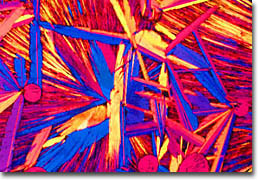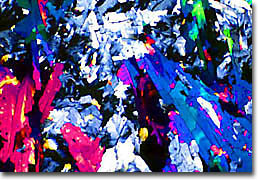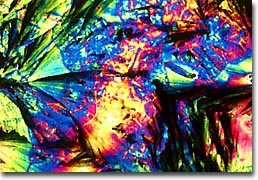|
Soft drinks have been an anchor in American culture since the beginning of the twentieth century, but the roots of these beverages extend much further back in time. The first carbonated soft drinks, which were named as such in order to clearly differentiate them from hard, alcoholic beverages, and the technology to make them were imported from the Europeans, who had discovered how to force carbon dioxide gas into water back in the sixteenth century. The original bubbly drinks were carbonated mineral waters mimicking those found in therapeutic natural springs and the first of these were patented in the United States in 1810. Less than a decade later, the soda fountain was patented as well. By the mid-1800s, American chemists and pharmacists were concocting sweetened, flavored carbonated beverages. According to John Mariani's The Dictionary of American Food and Drink, ginger, lemon, strawberry, and vanilla were the popular flavors of the time, but towards the end of the century, the first cola drinks, which would eventually revolutionize the soft drink industry, were being developed.

Arizona Iced Tea
In 1886, an Atlanta pharmacist named John Styth Pemberton invented a carbonated beverage that he called Coca-Cola, which was destined to become the world's best selling soft drink. Mixed with extracts of the tropical kola nut and cocaine from the coca leaf, the original Coca-Cola was hailed as a tonic for a variety of ailments, and considering its ingredients, presumably made its consumers feel more energized. Pemberton began selling the syrup for his beverage to soda fountains and was extremely successful, but sold his burgeoning business in 1891 to another local pharmacist, Asa Griggs Candler, who soon incorporated the company, which grew fast under his control. Bottling of Coca-Cola was underway before the dawn of the twentieth century and although the drink was reformulated in 1905 and the cocaine was eliminated, its popularity continued to increase. When the company changed hands again in 1919, it was bought for 25 million dollars, a drastic increase from the 100,000 dollars it had been valued at when it was incorporated a few decades earlier.

7 Up
Inspired by the success of Coca-Cola, a New Bern, North Carolina pharmacist named Caleb Bradham invented a new custom cola syrup mix during the 1890s. Added to carbonated water, the sweet beverage he created was originally known among his customers as "Brad's Drink," but soon was officially named Pepsi-Cola. Bradham incorporated his business in 1902, and though it was moderately successful for many years, after World War I problems began to emerge, especially due to the erratic prices of sugar, which was a crucial component of Pepsi-Cola. Despite many changes in the company during the 1920s, its fortune did not really begin to turn around until 1931, when it was acquired by Charles G. Guth, who oversaw a merger and many other modifications of the business as well as an important reformulation of the drink itself. The company became even more successful in 1950s, when Alfred N. Steele, who had previously served as a vice president of Coca-Cola, initiated massive advertising campaigns during his reign as chief executive officer. Though Steele died in 1959, by making Pepsi-Cola a highly recognizable icon of the soft drink world, his work continued to play a large part in the company's success.

Strawberry Slurpee
A third major soft drink brand was founded in 1905 in Columbus, Georgia, by yet another pharmacist, Claud A. Hatcher, who wanted to supply the grocery store owned by his family with his own drinks. The first cola he produced was dubbed Chero-Cola, but Hatcher also created other drinks, including ginger ale, root beer, and a strawberry-flavored soda, all of which comprised the Royal Crown line. Early success led Hatcher to found the Chero-Cola Company in 1912, but in the late 1920s a name change reestablished the same business as the Nehi Corporation, an alteration that reflected the business's production of a line of popular fruit-flavored drinks. When Hatcher passed away in 1933, control was transferred to H. R. Mott, who had been the vice president of the business previously, and a reformulation of Chero-Cola ensued. Released in its new form, the product was promoted under the name of the line it was originally a part of, Royal Crown, and the new drink proved to be such a sensation that the company's name was eventually changed again to the Royal Crown Cola Company. Over the years, many consumers came to genially call the drink RC, an abbreviated form of its official name.

Tonic Water
Though originally enjoyed in the belief that they could help cure common ailments, in modern times, soft drinks tantalize the mass market by promising a blend of fun and refreshment. The backbone of the soft drink industry continues to be comprised of Coca-Cola, Pepsi-Cola, and RC Cola, but these beverages by no means stand alone in the field. Today the soft drink industry is highly competitive with both carbonated and uncarbonated drinks going head-to-head in the marketplace. In the last few decades of the 1900s, for instance, a tremendous variety of flavored teas, such as those sold by the Arizona Beverages Company, emerged onto the soft drink market and quickly became popular. A broad array of bottled waters and juice drinks are also available. However, for some, the carbonated, thirst-quenching pleasure of soda pop cannot be surpassed. In fact, estimates show that in 2002, Americans consumed almost 53 gallons of carbonated soft drinks per person per year.
|




